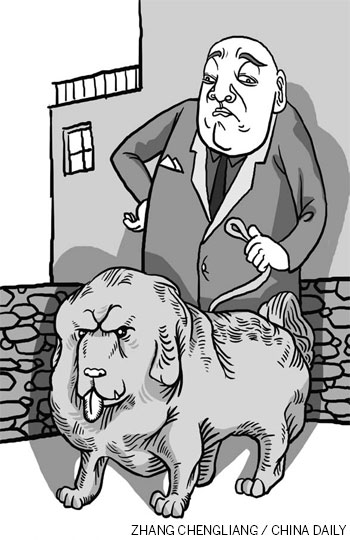Comment
A hot dog breeds new fear
By Linda Gibson (China Daily)
Updated: 2010-03-31 08:12
 |
Large Medium Small |

Something awful is happening to Tibetan mastiffs in China.
They've become the latest must-have accessory of the very rich, who are willing to pay absurd prices for these dogs solely because they are status symbols. Expos featuring Tibetan mastiffs, like the one on March 19 in Changping, are helping feed the frenzy.
Terrible things happen to dog breeds that experience this type of popularity. High prices lure inexperienced or unscrupulous breeders to churn out litters as quickly as possible. Some don't care if dogs are carelessly matched or even bred with their own offspring.
The result is the quality and temperament soon deteriorate, and poorly bred dogs suffer from physical ailments and their behavior becomes unpredictable. This leads owners to abandon them, rather than spend money on vet bills or obedience training.

Even a properly bred, healthy Tibetan mastiff presents a great challenge for most people, and Chinese aren't the most experienced dog owners.
A Tibetan mastiff needs a lot of exercise and plenty of socialization. "Otherwise, left alone, young Tibetan mastiffs become bored and destructive - and their powerful jaws can literally destroy your living room," cautioned an expert at the website YourPureBredPuppy.com.
"It is a fine guard dog, but too strong-willed and massive to make a good family dog," said the expert, adding, Tibetan mastiffs require continuous training, supervision and control "to prevent excessive suspiciousness or aggression toward other people."
Another website, Woofahs.com, warned that Tibetan mastiffs are so protective of their family and property, "it may be difficult to bring people into your home."
People with children shouldn't even consider getting a Tibetan mastiff. When young, the big dogs are so energetic they can easily knock over a small child. They also can mistake active, physical play between your child and a friend as a threat to a family member, and attack.
Look what happened to a breed that experienced the same kind of popularity as a status symbol in the United States - the pit bull.
At one time, this breed was prized for its strength, courageousness and loyalty. It served as a mascot for national brands like RCA and Buster Brown Shoes.
In World War I, a pit bull named Stubby won acclaim as a hero. Another, named Petie, co-starred with children in a television series called Our Gang. Famous people as varied as author Laura Ingalls, President Theodore Roosevelt and Helen Keller owned pit bulls.
And if a woman who was blind, deaf and mute could enjoy a pit bull as a pet, surely it had to be a friendly, obedient breed.
But starting in the 1980s, pit bulls became the breed of choice for drug lords, gang members and dog fighting fans. They willingly paid high prices for the dogs, leading to inbreeding and erratic temperaments. Many were bred and trained for aggressiveness, becoming macho status symbols for their male owners.
Inevitably, people started getting bitten and even killed by pit bulls. The dogs are now feared and despised. Hundreds of cities have banned them, and three states have tried.
Imagine what kind of mayhem could result from badly bred, poorly trained dogs that can be up to three times larger than pit bulls.
Too bad money can't buy common sense.
| 分享按钮 |